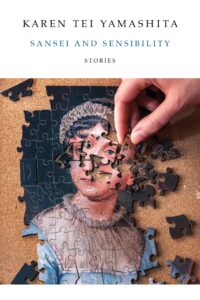
[Coffee House Press; 2020]
“You are a sansei,” opens “Colono:Scopy,” one of eighteen short stories in Karen Tei Yamashita’s latest collection, Sansei and Sensibility. This means you are a grandchild of Japanese-born immigrants in the Americas, or as Yamashita puts it, a member of “the sandwich generation, meaning you’re the baloney between your needy, illogical kids and your needy, illogical parents.” At this juncture in your life, moreover, you may find yourself in need of reading glasses and a colonoscopy.
Such is the timbre and scope of Yamashita’s eighth book to date, which frequently employs the second person to carry out her unique blend of playfulness and intellectualism. Part I, entitled “Sansei,” explores experiences of being sansei with an explicit attention to the social, cultural, and (inter)national positionality. She provides, for example, a timetable at the end of the section that depicts issei, nissei, and sansei — first, second, and third-generation immigrant — lifespans in relation to historical events concerning Japanese Americans living in Los Angeles and Gardena, California.
The chart reflects Yamashita’s extensive research on the topic, a well-established aspect of her fiction by now, where for Yamashita, information is always more complicated than its presentations, always human. “A Gentleman’s Agreement,” like her previous book, Letters to Memory (Coffee House Press; 2018),assumes an ethnographer’s lens, but a personal one. In the early 1900s, immigration rates of Japanese laborers to Brazil increased following U.S. exclusion acts passed specifically against them, a phenomenon which Yamashita engages through a series of biographical portraits of Japanese immigrants to both the U.S. and Brazil. The story’s narrator — like Yamashita, a sansei — describes leaving “that enclave of Japanese Americans in Gardena, California” decades after those major migrations in search of her “counterparts in Brazil,” only to meet nisei her age:
I had the strange sensation of meeting my parents’ generation in their youth. What was sansei? I was a figment of their imaginations. I had arrived in a time machine; and yet, I hadn’t. I had only come from up north. I was American, and every middle-class person on earth seems to know what that means.
The account complicates the intergenerational and transpacific dynamics informing Japanese American experiences by highlighting the tectonic nature of these timelines. Being sansei, for Yamashita, is much more multidimensional than a mere degree of generational displacement from Japan. The kind of time, the place(s) of its passing, the forms of distance created and preserved; all of it can locate and estrange.
Other stories are more light-hearted, though no less scrupulous. At the end of Part I, she curates a list of “sansei recipes,” playful snapshots of seemingly personalized recipes that in their blending of Japanese and western food cultures are conspicuously marked by colonial legacies. “Paul Yamazaki’s Natto-don,” for instance, calls for Colman’s mustard as well as Spam, the latter of which was famously disseminated by American G.I.s throughout the Pacific after Pearl Harbor.
As she demonstrates in “The Bath” and “The Dentist and The Dental Hygienist,” Yamashita is capable of stories that sit more comfortably in the tub or the dentist’s chair — that is, more comfortably in prescribed narrative shapes. But it’s in the section’s later stories that her trademark flamboyance comes forth and you can really feel her mind at work. It’s that torrent of voice she can spin out of anything, whether riffing on a visit to the gastroenterologist in “Colono:Scopy” or testing out Marie Kondo’s world-famous tidying methods in “KonMarimasu” (neither of which, being written in second person, have the tempered quality of “The Bath” or “The Dentist,” which are written in third).
But most readers are here for something else altogether. Which is not to say the stories in Part I aren’t important to Yamashita’s project at large — it’s just that the title of the collection broadcasts an expressly Janeite intrigue specific to Part II, accordingly entitled “Sensibility.” Admittedly, this was not my main draw to the collection, as I’m not an avid Janeite (yet). But fear not. Per usual, Yamashita has her bases covered. Her table of contents gives a heads up “to Janeite readers in search of Jane Austen: kindly skip to part II”, and for the rest of us who won’t catch all the allusions, she’s provided a “cheat sheet” at the end of the book.
It doesn’t take a Janeite, however, to enjoy these stories, or to sense that Yamashita’s engagement with Austen runs somewhere between pastiche and parody. This is where the second person, in its unique capacity to locate and estrange (a phrase I repeat here intentionally) reveals itself as a complex prism within which the narratorial gaze is thrown in directions that other points of view would not as easily accommodate. “Japanese American Gothic,” for instance, opens with a paragraph that reads as though the second person is determining itself:
In this story, you get to be the sansei heroine because you are like a lump of narrative Play-Doh, and the less self-awareness you possess, the more you can be poked, prodded, and punched into possibility. You are the heroine because we follow your adventure even if other characters might have better adventures and more interesting lives, because your adventure has moral authority, and because it’s a trick. This is not said to make you feel special or bad or even tricked; the real story is there, just not necessarily in your exact direction.
The “you” here is talking to itself and deciding on its agency, giving itself permission. You can feel Yamashita gravitating towards it in other parts of the collection and pulling back. She does so in the opening of “Giri and Gaman,” perhaps her goofiest Janeite mash-up, which recasts Mr. Darcy as a high school football stud. The social drama? Prom. But before all that, Yamashita’s narrator gives a rambling sort of introductory monologue with/in the second person:
The truth of the matter is that despite what you may think, sansei do have a sense of humor. O.K., let’s not be grandiose about it, but we always see you in groups laughing about something. What are you laughing about? What is there to laugh about? As for nisei, they do have a sense of humor; they just never laugh. It’s hard to test this theory because most nisei these days are well over eighty, and after eighty, 1. You’ve pretty much heard all the jokes; 2. You can’t hear, or you hear what you want to hear; 3. Dementia screws the funny bone; 4. If you laugh, you’ll pee; and 5. Nothing is funny. But would you laugh if you found out life was some kind of endurance test for which you sacrificed yourself to an abstract idea of duty?
The “you” here is dialogical, constantly shifting between singular and plural valances. One moment the “you” is sansei perceived by someone else, but then sansei are “we” and nisei are “they.” With another rhetorical pivot nisei become/s a form of “you.” In other words, “you” are sliding along the generational axis at the same time you are moving in and out of the singular or individual, and the plural or collective (perhaps an easy glance at eastern and western value systems while we’re at it). The thing to grasp is the narratorial echo chamber at play and the echo-location it paradoxically enacts: contrary to the pejorative sense of that term and image, the singular plurality of Yamashita’s chamber is, rather than self-defeating or conformist, particularizing: in its mutability, exact.
I should note that although it’s a recurring feature, the majority of the stories in the collection are not in second person. The final story, “Omaki-san,” for instance, is an epistolary family drama inspired by Lady Susan and by far the most compelling narrative in the book. That said, all stories in Part II open early with the phrase “Mukashi, mukashi,” (the Japanese for “Once upon a time”), an utterance which gestures to the frame around the Janeite elements in each piece. Sitting just outside that frame is Yamashita’s narratorial double. The opening to “Japanese American Gothic” is an instance of that second person stepping into the frame and seeing itself through the diegesis. “Giri and Gaman” opens similarly but shoos the voice away: “But enough pontificating. Back to storytelling.”
The “you” returns in the Afterword, in this case deeply aligned with Yamashita, if not outwardly alluding to her. It tells us what we’ve likely already detected by now, that for Yamashita, Jane Austen’s novels are a curious analog for sansei experience:
You grasp for some kind of relationship, and it occurs to you that maybe you can compare this Janeite society to growing up sansei. Not the carriages and grand plantation estates; face it, you grew up in city ghettos and plotted suburbs. Still, growing up sansei was very confusing . . . Everything that should have been obvious about American society and its promises of freedom and the future was on a standby basis, depending on you.
So, you are sansei after all. Well, depending. What’s exacted in your voice is the confusion, its specialty. At worst, the voice is so casual it can sound like everything is just occurring to you, like your trademark quip and verve is one tick too frenetic, but it’s clear in the end you are more than a mode for acrobatics. Indeed, you’re too busy in these stories to strain exclusively for style. For Yamashita, at least, you are a narratorial sensibility, an access point. The prism walls you operate within don’t confine you so much as sharply direct your gaze around silences that would otherwise obscure your knowledge of yourself. You peer periscopically over the hedge into the neighbor’s yard. Through the fray, past or present, you might find another you looking back.
Jed Munson is a graduate of Wesleyan University. He was born in Madison, Wisconsin.
This post may contain affiliate links.







